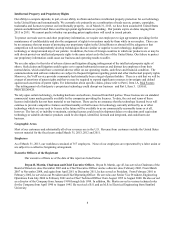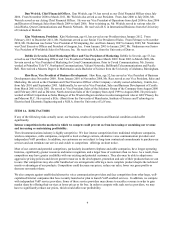8x8 2013 Annual Report Download - page 20
Download and view the complete annual report
Please find page 20 of the 2013 8x8 annual report below. You can navigate through the pages in the report by either clicking on the pages listed below, or by using the keyword search tool below to find specific information within the annual report.
18
initiated by the FCC or other agency or task force against us could have a material adverse effect on our business, financial
condition or operating results.
Delays our customers may encounter when making emergency services calls and any inability of the answering point to
automatically recognize the caller's location or telephone number can result in life threatening consequences. Customers may,
in the future, attempt to hold us responsible for any loss, damage, personal injury or death suffered as a result of any failure of
our E-911 services. In July 2008, the President signed into law the "New and Emerging Technologies 911 Improvement Act of
2008." The law provides public safety, interconnected VoIP providers and others involved in handling 911 calls the same
liability protections when handling 911 calls from interconnected VoIP users as from mobile or wired telephone service users.
The applicability of the liability protections to our national call center solution is unclear at the present time. Also, we may be
exposed to liability for 911 calls made prior to the adoption of this new law although we are unaware of any such liability.
The FCC may require us to deploy an E-911 service that automatically determines the location of our customers. The
adoption of such a requirement could increase our costs that could make our service more expensive, decrease our
profit margins, or both.
On June 1, 2007, the FCC released a Notice of Proposed Rulemaking in which it tentatively concluded that all interconnected
VoIP service providers that allow customers to use their service in more than one location (nomadic VoIP service providers
such as us) must utilize an automatic location technology that meets the same accuracy standards which apply to providers of
commercial mobile radio services (mobile phone service providers). In September 2010, the FCC released a Notice of Inquiry
again requesting comment on what type of automatic location standards should apply to providers of nomadic VoIP service
providers, whether the FCC's rules concerning the delivery of emergency services should be extended beyond providers of
interconnected VoIP services, and whether such emergency service obligations should apply to mobile VoIP applications used
on smartphones, computers and other devices. In July 2011, the FCC released a Second Further Notice of Proposed
Rulemaking, seeking comment on a number of issues including (i) whether to apply the FCC's E-911 rules to "outbound-only"
interconnected VoIP services (i.e., services that support placing calls to the PSTN); (ii) whether to adopt rules requiring all
interconnected VoIP service to automatically provide location information for emergency calls; and (iii) whether to revise the
FCC's definition of interconnected VoIP service to require an "Internet connection" rather than a broadband connection, and to
"define connectivity in terms of the ability to connect calls to the United States E.164 telephone numbers rather than the
PSTN." Also, the FCC released a Notice of Proposed Rulemaking that sought comment on whether any amendment of the
definition of interconnected VoIP service should be limited to E-911 requirements, or should apply other regulatory
requirements to these additional services. In September 2011, the FCC released a Notice of Proposed Rulemaking soliciting
comment on what role the agency could play in the fostering the development and implementation of newer 911 technologies
including, but not limited to, prioritization of 911 traffic triggered by an event such as a natural disaster, long-term
implementation of IP-based alternatives for delivering different kinds of media to emergency call takers like video,
photographs, and other forms of data, and text-to-911 solutions.
The outcome of these proceedings cannot be determined at this time and we may or may not be able to comply with any such
obligations that may be adopted. At present, we currently have no means to automatically identify the physical location of one
of our customers on the Internet. The FCC's VoIP E-911 order has increased our cost of doing business and may adversely
affect our ability to deliver the 8x8 service to new and existing customers in all geographic regions or to nomadic customers
who move to a location where emergency calling services compliant with the FCC's mandates are unavailable. Our compliance
with and increased costs due to the FCC's VoIP E-911 order put us at a competitive disadvantage to those VoIP service
providers who are either not subject to the requirements or have chosen not to comply with the FCC's mandates. We cannot
guarantee that emergency calling service consistent with the VoIP E-911 order will be available to all of our customers,
especially those accessing our services from outside of the United States. The FCC's current VoIP E-911 order or follow-on
orders or clarifications or their impact on our customers due to service price increases or other factors could have a material
adverse effect on our business, financial condition or operating results.
























